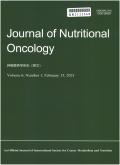Nutritional Risk Screening with NRS2002 among Hospitalized Cancer Patients in China
引用次数: 0
Abstract
Abstract: Objective The Nutritional Risk Screening 2002 (NRS 2002) was used to assess the nutritional risk of hospitalized oncology patients in China. This study explored the factors affecting the risk of nutrition to provide a scientific basis for the assessment and treatment of malnutrition in oncology patients. Methods We used the NRS 2002 to evaluate the nutritional risk in 48,831 hospitalized cancer patients. Descriptive statistical methods were used to describe the general patient information. A Chi-squared test was applied to analyze the relationship between NRS 2002 scores and different demographic characteristics, and the NRS 2002 scores of cancer patients with different characteristics were compared by one-way ANOVA. Results Among 48,831 patients, 43.3% were women and 57.7% were men, and 36.5% (17,802) of patients were at risk of nutrition (score ≥ 3). The NRS 2002 score was the highest in leukemia patients (2.93 ± 1.28). A one-way ANOVA revealed that the differences in NRS 2002 scores among patients of different gender, ages, TNM stages, education levels, occupations and areas of residence were statistically significant (P < 0.001). Male patients had slightly higher NRS 2002 scores than females (2.33 vs. 2.17). The lowest NRS 2002 scores were in patients aged 45-59 (2.00 ± 1.26) years and the highest scores were in patients aged ≥ 70 (2.76 ± 1.43) years. The NRS 2002 score of patients receiving surgery was the highest (2.45 ± 1.41), and patients receiving surgery plus radiotherapy/chemotherapy was the lowest (2.00 ± 1.26). The risk of nutrition was highest in patients who were farmers (2.34 ± 1.37 scores) and lowest in office staff (2.15 ± 1.32 scores). Patients living in rural areas had the highest risk of nutrition (2.32 ± 1.37 scores). There were significant differences in the NRS 2002 scores for different cancer sub-types for different ethnic groups (P < 0.05), except for Zhuang individuals (P = 0.124). The risk of nutrition was highest in Uyghur patients (3.35 ± 1.33 scores) and lowest in Mongolians (2.04 ± 1.37 scores). Conclusion More attention should be paid to people at high risk of nutrition, such as elderly patients, patients with a high TNM stage, patients receiving surgical treatment, and patients living in rural areas. Active nutritional interventions should be carried out to improve the nutritional status of malnourished patients.NRS2002在中国癌症住院患者营养风险筛查中的应用
摘要:目的应用营养风险筛查2002(NRS2002)对我国肿瘤住院患者的营养风险进行评估。本研究探讨了影响肿瘤患者营养风险的因素,为肿瘤患者营养不良的评估和治疗提供了科学依据。方法采用NRS 2002对48831例癌症住院患者的营养风险进行评价。采用描述性统计方法描述患者的一般信息。采用卡方检验分析不同人口学特征与NRS 2002评分之间的关系,并采用单因素方差分析法对癌症患者不同人口学特征的NRS 2002得分进行比较。结果48831例患者中,43.3%为女性,57.7%为男性,36.5%(17802)的患者存在营养风险(评分≥3)。NRS 2002评分在白血病患者中最高(2.93±1.28)。单因素方差分析显示,不同性别、年龄、TNM分期、教育水平、,男性患者的NRS 2002评分略高于女性(2.33对2.17)。年龄在45-59岁(2.00±1.26)岁的患者NRS 2002得分最低,年龄≥70岁的患者得分最高(2.76±1.43)。接受手术的患者的NRS 2002评分最高(2.45±1.41),接受手术加放疗/化疗的患者最低(2.00±1.26)。农民患者的营养风险最高(2.34±1.37分),办公室工作人员的营养风险最低(2.15±1.32分)。生活在农村地区的患者营养风险最高(2.32±1.37分)。不同民族不同癌症亚型的NRS 2002评分除壮族外,差异有显著性(P<0.05),维吾尔族患者营养风险最高(3.35±1.33分),蒙古族患者营养风险最低(2.04±1.37分)。结论应重视营养高危人群,如老年患者、TNM高分期患者、接受手术治疗的患者和农村患者。应采取积极的营养干预措施,改善营养不良患者的营养状况。
本文章由计算机程序翻译,如有差异,请以英文原文为准。
求助全文
约1分钟内获得全文
求助全文

 求助内容:
求助内容: 应助结果提醒方式:
应助结果提醒方式:


